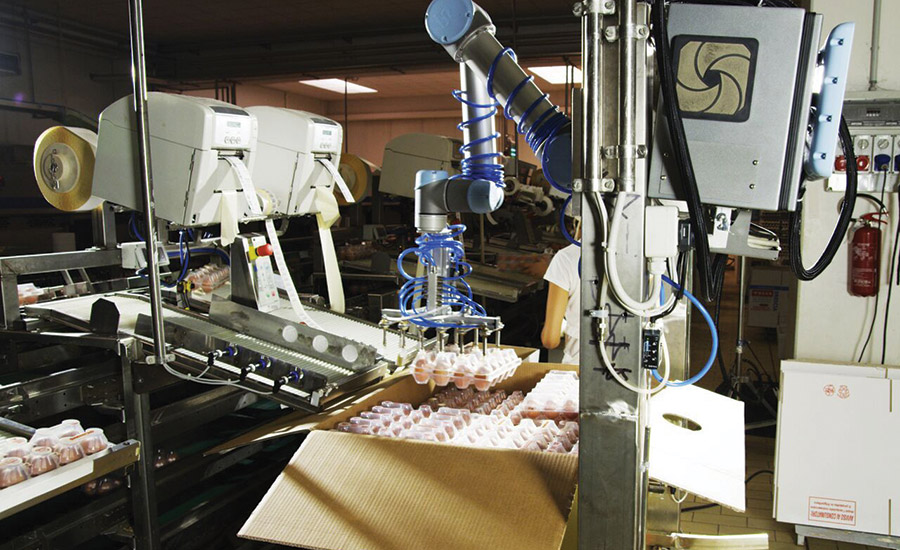At Cascina Italia S.p.A., in Spirano Bergamo, Italy, automated egg handling helps the company to speed up production while eliminating errors. Universal Robots’ (universal-robots.com) collaborative UR5 robot equipped with a pneumatic gripper gently picks and places trays of eggs to load corrugated cases with up to nine layers. The robot automates a task previously done by hand.
“It was highly repetitive, non-ergonomic and time wasting,” recalls Sergio Della Santina, technical manager at Alumotion S.R.L., Cernusco sul Naviglio, Milano, Italy, the integrator for the project.
The egg supplier has “registered an increase in capacity from 150 boxes per hour to 300 boxes per hour,” reports Ruggero Moretti, director at Cascina Italia.
This capacity boost is quadrupled since Cascina Italia has four filling lines equipped with a UR5 robot operating at about 10 cycles per minute. Three flexible lines handle boxes holding 96, 144 or 192 eggs. The fourth line is dedicated to a bigger box holding about 1,400 eggs. For the three flexible lines, Alumotion (alumotion.eu) provided the robot and its programming. The fourth line involved mounting the robot on a case-erecting machine, so the two entities are tightly coupled. The robots exchange digital and Modbus data to coordinate functions with other systems.
Upstream a machine erects boxes, which move into position for loading. Meanwhile, a conveyor carries packaged eggs to the loading point. When the correct collation of eggs is present, a photocell sends a signal, and the robot picks up the eggs and places them into the box. When the box is full, the robot sends a signal to move it downstream and requests an empty box.
All the filling stations release their full boxes onto the same downstream conveying line, so it is necessary to synchronize the stations in order to avoid collisions between the boxes. The logistics that handle the release priorities are implemented in each robot into a parallel thread. This thread (while the main program takes care of moving the eggs) is checking that no upcoming boxes are approaching and counts the boxes that are entering a critical portion of the downstream line that is close to the point where the filling station is placed. When the thread decides that a box can be released, it informs the main program and the releasing process begins.
The robots are quickly programmed onsite via a touchscreen control panel and Universal Robots’ Polyscope User Interface. Programming for the line dedicated to the 1,400-count boxes required only one day even though 54 different trajectories were involved (nine layers, six placing positions per layer).
“No offline activity is required. The teaching mode allows us to move the arm by hand and to acquire complicated movements on the fly. This makes it very easy to design and apply special filling trajectories that let the robot put the eggs into the boxes with a high speed and very low clearance,” says Della Santina.

